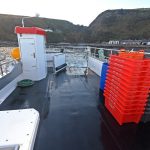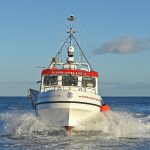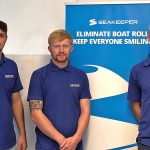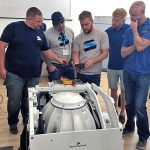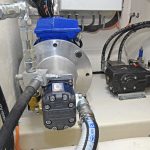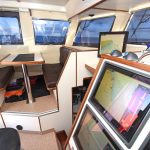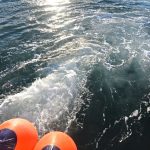Trefjar delivers second high-spec Cleopatra Fisherman 40 fast potter to Burnmouth owners in 18 months
The arrival of the 11.90m Soph-Ash-Jay 3 LH 60 at Burnmouth further strengthens the already strong bonds between Berwickshire owners John and Nicola Affleck and Icelandic boatbuilder Trefjar Ltd, reports David Linkie
Named after their daughters Sophie, Ashleigh and Jayda, the new boat is a virtual sistership to the Cleopatra Fisherman 40 Soph-Ash-Jay 2 LH 60, which started to fish from the Berwickshire harbour 18 months ago, and was recently renamed JAS-N 3 LH 50.

Soph-Ash-Jay 3’s extensive working deck enables 36in parlour pots to be worked in fleets of 50…
Externally, the two boats are identical in profile and dimensions. Also identical are the potting arrangements and the FPT C13 propulsion system, which gives a typical working speed of 12-14 knots and a top speed of 20 knots. Soph-Ash-Jay 3 and JAS-N 3 also feature Seakeeper gyro stabilising systems. The relatively minor differences include the new-build being fitted with a stern thruster as well as a bow unit, and the presence of a hydraulically driven seawater pressure-washer for cleaning pots at sea.
The longstanding association between boatbuilders and owners now spans 15 years and four new boats, dating back to 2003 when the Cleopatra Fisherman 33 Soph-Ash 2 BK 533 became the first new creel boat to fish from Burnmouth in over 20 years.
The successful performance skipper and crew achieved with this boat over the next four years, while working new grounds further offshore, led to the arrival of the Cleopatra Fisherman 38 Soph-Ash-Jay BK 541.
The strong bonds between owners and builders, based on total customer satisfaction and mutual trust, also underpin a number of other equally important long-term associations that John and Nicola Affleck have with service, supply and processing companies, including Sunderland Marine, Caithness Creels, Gael Force, SIRM UK, Charity & Taylor/Furuno UK and DR Collin & Son Ltd. This highlights the customer loyalty and trust that is vital to any successful business.

… and self-shot through the portside opening in the transom.
Six weeks after taking delivery of Soph-Ash 2 in 2003, skipper John Affleck said: “If the shellfish opportunities warrant another new boat in a few years’ time, I will have no hesitation in returning to Iceland, possibly for a Fisherman 38. Time will tell.” That these far-sighted thoughts have now been repeated on a further three occasions underlines the strength of the enduring relationship that developed subsequently.
While waiting for Soph-Ash-Jay 3’s fishing licence and related paperwork to be processed, skipper John Affleck said, “As far as I’m concerned, the end result says all that needs to be said in terms of build quality, machinery installation and level of finish. Although from previous experience, we had a fair idea what to expect, nonetheless you are still surprised, as Trefjar continue to push the bar ever higher. I cannot speak highly enough about the co-operation Trefjar has provided down the years, and their unwavering commitment to ensuring total customer satisfaction.
“Once again, technical director Hogni Bergthorsson and his colleagues have been superb to work with. Now it is up to us to follow Trefjar’s standards by proving the potting capabilities of Soph-Ash-Jay 3.
“Taking on a new boat inevitably involves a significant amount of extra work, particularly for a family business. Starting with Nicola, who dealt with the seemingly endless paperwork, in addition to keeping on top of the usual weekly bookwork, a lot of people have contributed to the end result. The long list includes JAS-N 3 skipper Neil Rutherford and Faizan Sindhoo, Marcel de Sousa and Jack Robinson, as well as shore manager Jason Straughan. Thanks also go to Scott Lindores, Tony Barlow, and my father Alistair for maintaining our gear, and James Cook and the DR Collin team, for always being available to take our shellfish catches. They have done this for the past 30 years, during which time the company has continued to develop discerning niche markets in Europe for prime creel-caught shellfish.”
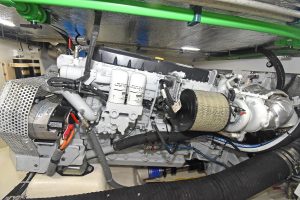
Soph-Ash-Jay 3 is powered by an FPT 13 main engine.
John Affleck also expressed his appreciation to Soph-Ash-Jay 3’s insurer, Sunderland Marine, and in particular to Michael Thomson, for arranging the additional special insurance required to tranship the fast potter from Iceland to Immingham.
Soph-Ash-Jay 3, together with her sistership JAS-N 3, is expected to fish a seasonal combination of lobsters and brown and velvet crabs within a 30- to 50-mile radius of Burnmouth. Reflecting the varied pattern of working associated with prevailing sea conditions, Soph-Ash-Jay 3 features a versatile catch-storage system in the fishroom, in which up to 116 boxes of shellfish can be kept in optimum condition, before being landed at any time to the Eyemouth-based live shellfish export company DR Collin.
Constructed from hand-laid GRP, an isophthalic gelcoat and a balsawood core sandwich deck, Soph-Ash-Jay 3’s semi-displacement hull, in which the full beam is continued down to well below the waterline before blending into a deep V-section hull, includes a bulbous bow.

Over 100 boxes of shellfish can be kept in the midships fishroom, which is served by a powerful deckhead sprinkler system.
With an overall length of 11.90m, beam of 3.80m, moulded depth of 1.40m and draft of 1.10m, Soph-Ash-Jay 3 has 30m² of flush working deck space, ensuring that the vessel comfortably meets the requirements of static-gear fishing. Watertight bulkheads divide the hull from forward into accommodation cabin, a compartment under the wheelhouse containing the freshwater tank, fishroom amidships, engineroom, and steering gear compartment.
A walk-in engineroom coaming is positioned aft on the starboard side of the main deck.
Pot hauling and shooting activities onboard Soph-Ash-Jay 3 are centred on a self-hauling and shooting system, and mirror arrangements on JAS-N 3, reflecting the skipper and crew’s total satisfaction with them. Stainless steel has been extensively used in the vicinity of all areas of potential wear, to minimise maintenance in years to come.
A 1.5t Hydroslave 17in-diameter hauler is vertically mounted towards the vessel’s centreline on the aft bulkhead of the wheelhouse, which is angled forward to ensure that the backrope leads as far forward as possible. Integral stainless steel brackets (and a roller forward) are fitted at each end of the large-diameter gunwale-mounted roller, to retain the backrope and guide the creels aboard. Well-protected duplicate engine and Simrad remote steering controls are mounted on the gunwale rail aft of the hauling position close by, enabling Soph-Ash-Jay 3 to be easily steamed up through the tide to the gear.

The 1.5t Hydroslave pot hauler.
Pots are hauled onto an integral table for clearing and rebaiting before being stacked down the portside, ready to be self-shot through the portside opening in the transom.
After being cleared from the parlour end, brown crab are selected, in accordance with market requirements (size, cocks/hens), into one of three standard stacking fish boxes, placed in a shallow inclined rack mounted atop the starboard gunwale aft of the hauling position, before being stored in the hold amidships.
Skipper John Affleck, together with crewmen Kyle Jeffels, Paul Wakenshaw and Jack McLeod, works a combination of rectangular and D-section parlour pots, ranging in size from 36in to 48in, when fishing down to 40 fathoms. Spaced at 11-fathom intervals on 16mm-diameter Polysteel backropes sourced exclusively from Gael Force, the biggest parlours are worked in fleets of 40, and the smaller pots in 50s. The various sizes of new pots mainly come from John Sinclair of Caithness Creels, Wick.
The biggest parlour creels are placed three high, side-on to the gunwale rail, before being lifted down onto the deck when shooting away. Worked in longer fleets, the smaller parlours

Controls for the hauler, steering, bow/stern thrusters and engine, mounted on the gunwale rail abaft the hauling station, are well-protected.
are boxed alternately side- and end-on, four high.
Working closely with James Cook of DR Collin at all times, to achieve consistent top-level prices for his shellfish catches, skipper John Affleck has again placed particular emphasis on optimising catch-storage facilities on Soph-Ash-Jay 3, in line with the varying working patterns the boat is expected to follow, relative to the grounds being fished and weather conditions.
Boxes of shellfish placed in the fishroom are continually sprayed with seawater from a powerful deckhead-mounted sprinkler system, for which water supplies are generated by two electrically driven 1.5in Pedrollo pumps. Seawater is returned over the side by three high-capacity Rule 3,700 gallon/hr pumps, working on two separate float switches for maximum safety. A fourth back-up is provided by a manual pump. There is also an independent alarm float switch, should the level rise too much for any reason.
Storage space in the hold is maximised by positioning the fuel tank under the floor, as on JAS-N 3. In addition to enhancing vessel stability, by locating the weight of the fuel closer to the keel, this change, together with the LOA differential between the Cleopatra Fisherman 38 design and the updated 40 version, has created a longer fishroom, in which 112 boxes of shellfish can be placed three high, compared to 80 boxes on JAS-N 2.

Two of the three berths arranged in the accommodation cabin…
Soph-Ash-Jay 3 is powered by an FPT C13 12.9-litre main engine. Delivering 441kW @ 2,400rpm, the main engine is coupled to a new ZF 325IV 2.03:1 reduction V-drive gearbox, to drive a 750mm-diameter, five-bladed skewed propeller. BT Marine Propellers of Newton Abbot, Devon, supplied the potter’s complete stern gear package, which consists of a 70mm-diameter Duplex shaft and GRP stern tube with Tides seals.
In line with a similar stern gear package installed on previous boats, the propeller is optimised for cruising speed and economy, rather than all-out speed. Early indications are that this specification has been achieved, as Soph-Ash-Jay 3 cruises at 12-14 knots at 2,000rpm, while a top speed of 21 knots was achieved on sea trials in Iceland.
The main engine is reserved for propulsion duties only, apart from operating the 13kW bow and stern thrusters from gearbox-mounted drives. Electrically operated Zipwake stainless steel trim taps are fitted to enhance steaming efficiency. A stainless steel flap rudder is also fitted, for maximum manoeuvrability.
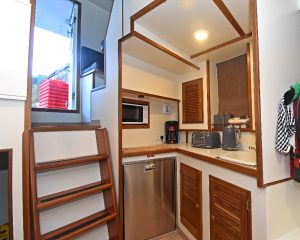
… forward of the well-equipped galley to port.
As is customary on Cleopatra Fisherman boats, ZF Mathers electronic engine controls are fitted. Trefjar has installed over 150 of these units on boats around the world. They work faultlessly down to -30°C on boats fishing around Greenland, and do not rust like some standard push-pull cable systems do. ZF Mathers controls are always easy to operate, especially when used in trolling valve function, to give full control at slow engine speeds when working the boat up to static gear.
The considerable space available in the engineroom and adjoining steering gear compartment has been used to maximum effect, with full advantage being taken of the additional bulkhead of the steering gear compartment to mount equipment and machinery on.
A SCAM diesel 17kW generator, sourced directly from the manufacturers in Croatia, is positioned forward on the portside of the engineroom. The generator provides a 230V AC single-phase and three-phase AC supplies, with the latter powering the hydraulically operated pot hauler via an 11kW electric motor. Also fitted are 24V DC domestic and 24V DC engine-starting electrical circuits, both bi-polar wired, and a 230V shore supply.
The provision of a PTO on the main engine gearbox and a crossover valve provide an alternative drive system for the Hydroslave hauler in the unlikely event of any electrical difficulties arising while potting.

Starboard…
A fuel tank with a 1,500-litre capacity is located under the fishroom floor. A tank adjacent to the accommodation/fishroom bulkhead houses 250 litres of freshwater.
As is customary on all Trefjar boats, the heavily insulated internal accommodation spaces on Soph-Ash-Jay 3 are fitted out to an exceptionally high standard, with the extensive use of teak. All the wheelhouse windows are electrically heated, while electric heaters are also fitted in the engineroom and cabin. In addition to three full-sized bunks and bench seating, the forward cabin also houses a well-equipped galley on the portside, complete with microwave, fridge, oven, sink, etc.
In the wheelhouse, the main steering console, which was designed by Trefjar in close liaison with skipper John Affleck, is arranged to starboard, forward of the Grammer helmsman’s chair. Joystick steering controls, rather than a conventional ship’s wheel, and a bank of sloping 19in flat screens, grouped around the steering position, reflect the ultra-modern technology present in the wheelhouse. A table, and seating for three men, lies to port.
Maximal levels of vision are provided by independently operated wipers/washers and anti-glare blinds.
Continuing Burnmouth and Iceland links
John and Nicola Affleck’s longstanding association with Icelandic boatbuilders Trefjar began in 2003, when they took delivery of the Cleopatra Fisherman 33 Soph-Ash 2 BK 533.

Stem and broadside views of the Cleopatra Fisherman 40s that Icelandic boatbuilders Trefjar delivered within 18 months of each other to John and Nicola Affleck.
The new boat replaced the original Soph-Ash BK 519, a Cyfish 33, which was sold to Campbeltown. John Affleck had fished Soph-Ash BK 519 for four years, after starting with his first boat, the 26ft Little Dot P 84.
The successful performance achieved by Soph-Ash 2 led to the new Cleopatra Fisherman 38 Soph-Ash-Jay BK 541 arriving at Burnmouth from Iceland in 2008, when her predecessor was bought by Shaun Brigham and Richard Ward of Holy Island, and renamed Fulmar II. This boat was bought by Shetland skipper Ronnie Young and renamed Cornucopja LK 372 earlier this year (Fishing News, 8 March, 2018).
In 2013, John and Nicola Affleck further strengthened their association with Trefjar by purchasing the eight-year-old Cleopatra Fisherman 33 Portia BK 110 from Seahouses skipper Neal Priestly. On arrival at Burnmouth, this fast potter was renamed JAS-N LH 50 and skippered by Neil Rutherford.
Two years later, the Cleopatra Fisherman 38 Soph-Ash-Jay, by now re-registered LH 60, was extensively refurbished by Trefjar in Iceland, when a new FPT C13 main engine and ZF gearbox were installed.
When the Cleopatra Fisherman 33 JAS-N was bought by Donnie and Richard Craig of Stonehaven in the spring of 2017 and renamed Solis-C ME 5, Soph-Ash-Jay was renamed JAS-N 2 LH 50, in preparation for the arrival of Soph-Ash-Jay 2 LH 60.
A similar sequence of boat sale and name changes took place two months ago, when John and Nicola Affleck sold the Cleopatra Fisherman 38 JAS-N 2 to Stonehaven father and son Richard and Donnie Craig, who have renamed this boat Solis II ME 5.
At the same time as Soph-Ash-Jay 2 LH 2 was renamed JAS-N 3 LH 50, the equally important task of displaying the skippers’ football loyalties on the stems of the Cleopatra Fisherman 40s was carried out, with NUFC again going on Neil Rutherford’s boat and RFC on the new boat.
Comprehensive seabed mapping and ground discrimination systems

High-tech seabed mapping and plotting systems feature prominently in the well-equipped wheelhouse.
An extensive range of bottom-marking and plotting equipment is included in the array of electronics equipment installed on Soph-Ash-Jay 3, to provide skipper John Affleck with the maximum amount of information when selecting ground before shooting away pots.
Furuno UK agents Charity & Taylor supplied a WASSP WMB 3230 multi-beam sonar (160 kHz) and MaxSea TimeZero plotting systems. John Affleck expressed his thanks to Alan Buchan of Furuno UK and Fraser Reid, senior engineer at Charity & Taylor’s Grangemouth depot, for the support and assistance they provided in supplying and commissioning this equipment.
Ground discrimination modules interfaced from the WASSP are incorporated into the 3D seafloor mapping displays for the MaxSea TimeZero and Olex plotters.
Tommy Lough of SIRM UK, who has worked closely with John Affleck on his previous boats, again liaised with him to design an electronics package specifically suited to the new vessel, with a clear understanding of the different requirements the new boat will have.
The state-of-the-art package included six Neovo LCD displays and a JRC JLR-21 GPS compass connected to a Simrad AP70 autopilot system. The autopilot has full follow-up controls and rudder indication from the hauling position on deck.

The split-screen CCTV display in the overhead console includes imagery from the underwater camera monitoring the propeller and rudder.
SIRM UK also supplied a Simrad R2009 radar with 4G broadband radome, a Simrad multifunction touch-screen NSS12 12in Navstation with built-in CHIRP-enabled broadband sounder, Simrad GO7XSE 7in Chartplotter, Class B AIS that is interfaced to a dual-screen Olex 3D seabed mapping system, Furuno GP-39 GPS receiver, two Sailor 6215 DSC VHFs, and a motion sensor which, interfaced to the WASSP system, provides details of pitch, roll and heave for accurate mapping of the seafloor.
As communication with the shore is extremely important, SIRM installed a KVH V3 VSAT system, particularly designed to suit smaller vessels without compromising on performance.
A CCTV system, incorporating an underwater camera covering the propeller and rope cutters, provides continual visual coverage of the engineroom from cameras in three different locations.
Repeat installation of Seakeeper gyro stabilising system
Soph-Ash-Jay 3 is the second new UK fishing vessel to feature a Seakeeper gyro stabilising system. Having been highly impressed by the performance of a similar unit on Soph-Ash-Jay 2, skipper John Affleck had no hesitation in including a similar Seakeeper computer-controlled gyroscope stabilisation system, designed to eliminate up to 95% of boat roll, in the build specification for the new boat.

The compact Seakeeper 6 gyro stabilisation unit is fitted to starboard in the engineroom…
Burnmouth skipper John Affleck thereby joins a succession of skippers in Iceland and Norway who are quick to say that, having experienced the benefits associated with gyro stabilising systems (other makes, including Mitsubishi, are available), they would no longer consider going to sea without one.
Essentially, the anti-roll system features a flywheel spinning at speeds of up to 9,700rpm inside a vacuum encapsulation sphere. When the boat rolls, the gyro tilts fore and aft (precesses), producing a powerful gyroscopic torque to port and starboard that counteracts the boat roll.
By operating at speeds up to 557mph, the flywheel generates enough force to stop a boat from rolling.
Manufactured in America, Seakeeper’s vacuum encapsulation enables the flywheel to spin approximately three times faster, cuts the flywheel weight by two-thirds, and halves power requirements. Because the critical components (flywheel, bearings and motor) are sealed in a vacuum, they are forever isolated from the marine environment.
A patented cooling system removes heat from within the vacuum enclosure, and dissipates it through a glycol/seawater combination. This enables the flywheel to spin at extremely high speed, providing ultimate performance in the smallest and lightest package possible.
The Seakeeper’s active control works as smart technology, automatically gauging the sea state and reacting instantaneously, allowing for optimal performance at all speeds and in all sea conditions.
The Seakeeper 6 is designed for use on boats of 12-15m and up to 20t. Various other models are available, suitable for vessels up to 26m and 100t. Multi-unit installations enable vessels over 70m to be fully stabilised with equal effect.

… and operated from a touch-screen console panel in the overhead wheelhouse console.
On Soph-Ash-Jay 3 the compact unit is fitted in the starboard side of the main engine compartment, although units can be installed virtually anywhere there is space.
On initialising at the start of a trip, the Seakeeper 6’s flywheel takes 40 minutes to reach full operational speed, during which time it is powered by a 5kW three-phase motor from the SCAM diesel generator, after which it is run off an inverter/battery supply.
In order to eliminate the need to constantly run the genset, which is primarily intended to operate the hydraulic pump for the Hydroslave hauler, FPT supplied and fitted a second alternator to the C13 main engine, together with another bank of batteries and a 5kW Victron inverter. This arrangement allows the Seakeeper to continue operating at full efficiency when Soph-Ash-Jay 3 is steaming off and returning to harbour, moving between fleets, and shooting away gear.
In addition to making life more comfortable at sea and increasing propulsion efficiency, the Seakeeper also significantly reduces strain on the potting gear when hauling.
Aquamare Marine becomes authorised Seakeeper dealer in the UK

Aquamare Marine service technicians Carl Pook, Luke Wilcox and Lee Jones in Lavagna, Italy…
Aquamare Marine has recently been appointed UK agent for Seakeeper gyro stabilisation systems, adding to the Plymouth company’s growing brand portfolio.
Seakeeper is a leader in marine stabilisation, designing gyroscopic stabilisation for vessels ranging from approximately 8m to 70m in length.
Aquamare Marine technicians Lee Jones, Carl Pook and Luke Wilcox completed the Seakeeper training in October in Lavagna, Italy. During the course, the three technicians learned the nuances of refit installation, service and maintenance. Following the training, each technician earned a certificate that makes them among a select few throughout the world able to provide full-service support to Seakeeper clientele.
Mike Sommerfeld, Aquamare’s marine director, said: “We’re excited to join the Seakeeper team, and will continue to offer the top-notch service all of our clients have become accustomed to. Adding Seakeeper to our service proves that we’re capable – and expert – in installing and servicing the best products the marine industry has to offer.”

… where they gained their Seakeeper installation and service certificates.
“We participate in a number of events in the United Kingdom and throughout Europe,” said Tanja Lutz, Seakeeper EMEA sales manager. “We’re growing in the region, and excited to work with Aquamare Marine. It’s abundantly clear to us that their clients put the utmost trust in them, and we’re doing the same as they join our integral dealer network.”
Aquamare will begin offering sales and service on Seakeeper units immediately. Interested parties should contact Alan Johnson (info@aquamare.co.uk) for vessel sizing and quotes. In addition to Seakeeper, Aquamare Marine is also an authorised dealer for AquaAir, CEM pumps, Icom, Intellian, Opacmare, Planus, Siminetti, Sonic-Shield, SuperSail, Tecnicomar and Xenta systems.
Established in 2009, Aquamare Marine (aquamaremarine.com) employs 25 people worldwide from three key locations. The head office is in Plymouth, with further offices in West Palm Beach, Florida, and on the Gold Coast in Australia. Aquamare Marine specialises in sales and support for the marine industry, offering a unique service where it supports everything it sells with a team of experienced engineers.
State-of-the-art boats further enhance Burnmouth’s strong potting traditions
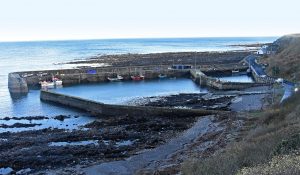
Burnmouth harbour has a long association with brown crab and lobster.
The presence of the 12m sisterships Soph-Ash-Jay 3 and JAS-N 3 berthed in Burnmouth’s picturesque harbour, at the foot of steep cliffs, is a reminder of the degree of change that has been experienced in half a century.
It also illustrates a high degree of confidence in the long-term future of offshore shellfish stocks in southeast Scotland and northeast England.
Burnmouth was, at one time, Scotland’s leading shellfish port, with a strong fleet of boats working creels on an extensive area of hard but shallow grounds lying southeast of the harbour down to Goswick Bay, Holy Island and the Longstones.
Shellfish auctions were held on the pier each afternoon, shortly after up to 10 traditional wooden-hulled boats, ranging from 30-45ft LOA, landed their catches, with brown crab being quickly packed into wooden barrels and taken ‘up the brae’ to Burnmouth railway station for delivery to Billingsgate via the late-afternoon Aberdeen fish train. Although the crab auctions finished in the late 1960s, lobsters continued to be sold daily by this method until diminishing landings resulted in this facility being withdrawn in 1982.

Soph-Ash-Jay 3 and JAS-N 3 alongside in the outer harbour.
In the 1960s, the 40ft boats Starlight and Golden Dawn, skippered by Willie Struthers and Robert Anderson, were the largest full-time creel boats, fishing some 15-20 miles to the south with a crew of five each, supplying 60 creels. Some of the larger boats, including Willie Martin’s Braw Lads and Robin Aitchison’s Fertile, combined potting with seine-netting.
At this time, several other Burnmouth skippers, including brothers Jim and John Aitchison, Norman Dougal and Davy Aitchison, moved to seining all year round, after taking delivery of their respective new 50ft boats White Heather IV, Heatherbelle II, Good Hope and Ivanhoe.
From the late 1960s, several new 35ft well-decked crabbers, including Village Belle, Restless Wave, Fast Castle, Challenge and Orient, were built for local skippers, replacing more traditional creel boats, while Robin Aitchison took delivery of the potter/trawler St Nicholas II.
Changes to a previously traditional way of life were perhaps inevitable, and gradually crept in around the late 1970s, before the decline of the local shellfish fleet accelerated, as catch rates from the traditional grounds dropped markedly in the late 1980s.
For reasons that will probably never be fully understood, apart from natural stock variation, the numbers of brown crabs, and particularly lobsters during the main late-summer season, steadily increased. This much-needed impetus was further helped by encouraging quantities of velvet crabs that provided an alternative seasonal fishery, and new marketing opportunities. Subsequently enhanced by forward-thinking stock conservation measures, this gave renewed hope to the remaining creel fishermen at Burnmouth, including a young John Affleck.
At the same time as fishing among the dry rocks as far south as Berwick, whenever sea conditions permitted, and on other traditional grounds south towards Holy Island, new grounds further offshore slowly came into play, while always ensuring that catching effort was closely matched to market demand.
This policy continues today, with a relatively small but hard-working fleet of boats maintaining Burnmouth’s proud shellfish traditions, which less than a generation ago, few would have thought would be maintained for much longer.
SOPH-ASH-JAY 3 LH 60
DETAILS
Owners: John and Nicola Affleck, Burnmouth, Berwickshire
Designer/boatyard: Trefjar Ltd, Iceland
DIMENSIONS and CAPACITIES
Length overall: 11.90m; Length reg: 11.88m;
Beam: 3.80m; Depth moulded: 1.40m; Draft: 1.10m; Tonnage: 7.8t gross; Fuel: 1,500 litres; Freshwater: 250 litres; Fishroom: 116 boxes
ENGINEROOM
Main engine: FPT C13
12.9-litre of 441kW @ 2,400rpm driving through a ZF 325IV
2.03:1 reduction V-drive
gearbox to a 750mm-diameter five-bladed propeller
Speed: 21 knots
Auxiliary engine: SCAN diesel 17kW generator Thrusters: Bow/stern 13kW hydraulically drivenGyro stabilising system: Seakeeper 6
DECK MACHINERY
Hydroslave pot hauler 17in diameter; 1.5t
SHELLFISH HOLD
Storage capacity: 116 boxes. Deckhead seawater sprinkler system supplied by two 1.5in Pedrollo pumps. Drained by three Rule 3,700-gallon/hr pumps operated by two float switches
ELECTRONICS
Suppliers: SIRM UK, Eyemouth and Charity & Taylor, Grangemouth
Bottom-sounding
WASSP WMB 3230 multi-beam sonar (160kHz); Simrad NSS12 Navstation c/w CHIRP-enabled broadband sounder
Navigation
Simrad R2009 radar; Furuno GP-39 GPS receiver; Olex 3D dual-screen seabed mapping system; MaxSea TimeZero plotting system; Simrad GO7XSE 7in chart plotter; Simrad AP70 autopilot; JRC JLR-21 GPS compasss
Communications
2 x Sailor 6215 DSC VHFs; KVH V3 VSAT system; Digital Yacht Class B AIS
FISHING GEAR
Pots: Caithness Creels –
36-46in parlours; Ropes:
Gael Force – Polysteel
16mm-diameter
ACCOMMODATION
1 x three-berth cabin
GENERAL
Engine controls: ZF Mather – electronic; Insurance: Sunderland Marine; Lifesaving appliances: 2 x Seago offshore liferafts; Steering: KN; Wheelhouse seat: Grammer; Wipers: ROCA






